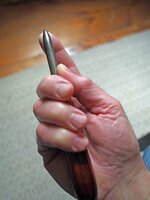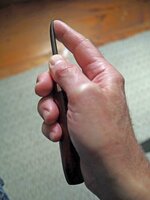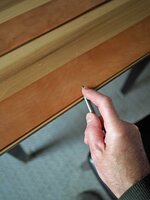I bought a vintage strop that didn't have good pictures but I got it so cheap I figured even if there was a little damage I couldn't see I'd take the Gamble. it arrived in good shape except there's a single gouge almost entirely through the depth of the strop along the right edge right in the middle. It's a 2.75 inch strop, and I could cut this gouge out and leave a nearly 2.5 inch strop... My concern is if I went down the length of the strop with a razor to cut the leather down to 24x2.5 from 24x 2.75, what's the easiest way to make sure it's a nice clean edge after the cut and is it possible to do it at home without any special tools?
You are using an out of date browser. It may not display this or other websites correctly.
You should upgrade or use an alternative browser.
You should upgrade or use an alternative browser.
Strop-makers... Easy way to clean up the edge of a strop?
- Thread starter SliceOfLife
- Start date
I don't have strop makers answer for you, as I have never done so, but I have used the fiskars cutting wheels to cut other leathers. Including some fairly thick leathers for axe sheathes. They are available at hobby stores and a new blade should cut it smoothly. They are similar to very sharp pizza cutters.
OK, seems to be called an edge beveler. Here is a cheap one:
Then, it is much nicer if you burnish the edge with something like this. You can do it dry, with water, beeswax, and they sell products but not necessary as even dry is better than not at all:
Quick YouTube google and there is this guy demonstrating both, albeit a little over the top and goofy. You can ignore much but at least see how a beveler is pushed down the edge and how the slicker is used to burnish.
Then, it is much nicer if you burnish the edge with something like this. You can do it dry, with water, beeswax, and they sell products but not necessary as even dry is better than not at all:
Quick YouTube google and there is this guy demonstrating both, albeit a little over the top and goofy. You can ignore much but at least see how a beveler is pushed down the edge and how the slicker is used to burnish.
LJS nailed it. These are exactly what you need. Many makers leave square edges if you don't want to invest in any tools but I feel the hard, 90 deg edge tends to catch on a blade too easily and risks nicks and damage. Beveled , or at least burnished or slicked just looks nicer too
- Thread starter
- #6
Thanks Guys, Really appreciate the help. I'll take some pics and post the results when I have time to give it a shot.
I've used a burnisher used in etching to bring down a recently-cut edge of a strop. Works quite well for this, with the burnisher's face being held at an approximate 45-degree angle to the edge.
I've used a burnisher used in etching to bring down a recently-cut edge of a strop.
I don't know what that is exactly, but it wouldn't surprise me one bit that it works fine if held right. I just linked a cheap slicker multi-tool, but I have a thick glass slicker (burnisher), a bone one, an agate type stone, etc. Read much from Japanese strop or razor folks and you will see mention of using a nagura stone - they don't detail but I am sure it is a well polished and smooth nagura without sharp edges which would make for a fine slicker which is what they are doing essentially even if they don't call it that.
The wooden slicker with the burnishing notches I linked is inexpensive and works pretty well and easily because it can (without sharp edges) compress both sides of the leather (flesh and hide) at the same time. If you bevel both sides before you burnish it really makes for a nice clean edge.
Yes a beveler. They come in many sizes, so get the right one/size. The gap between the prongs determine the bevel width and depth.

- Thread starter
- #10
Picked up a set of 4. Will be a week for delivery, but I'll update when they get here. Thanks. I'll probably just use a wooden french rolling pin to burnish... doesn't look like there's anything special about the burnishing tools unless I'm missing something?
doesn't look like there's anything special about the burnishing tools unless I'm missing something?
Nothing really special other than smooth. For an edge, it will work a lot better if you have some sort of notch or groove. The little stick is sort of a multi tool in that it has what I would call a slicker part (the conical part) and edge burnishing part (the grooves) that can be separate tools and are for different uses. The slicker is more for flats and on leather surfaces and the burnishers are for edges specifically. But in the end it is all just smooth wood or object, so anything can work. But the groove/notch is what will give your edges that nice uniform look you asked about initially. You can probably do it with rolling pin (more of a slicker) but it may not really round and burnish the edge fully. One of the things the grooves slick over are the exposed fibers on the edges and press it into a smooth edge shape instead of tattered. Might can do it with a rolling pin, not sure.
Google edge burnisher or leather burnisher and you will see numerous makes and styles and you may have a spindle around already that may suit or can easily whittle one. I have some muddle sticks in the bar and kitchen that are essential the same thing. Many look like a tinker toys if you have kids around.
I don't know what that is exactly, but it wouldn't surprise me one bit that it works fine if held right. I just linked a cheap slicker multi-tool, but I have a thick glass slicker (burnisher), a bone one, an agate type stone, etc. Read much from Japanese strop or razor folks and you will see mention of using a nagura stone - they don't detail but I am sure it is a well polished and smooth nagura without sharp edges which would make for a fine slicker which is what they are doing essentially even if they don't call it that.
The wooden slicker with the burnishing notches I linked is inexpensive and works pretty well and easily because it can (without sharp edges) compress both sides of the leather (flesh and hide) at the same time. If you bevel both sides before you burnish it really makes for a nice clean edge.
Here are shots of my etching burnisher. Wooden handle with brass ferule. Costs around $10 in an art-supply store. The last shot is with an un-burnished edge, to show the orientation of the tool during the stroke. The edge of the strop is lined as closely to the edge of the tabletop as possible. (Could be closer here, but I was shooting with one hand.) Fingertip is placed as it is to direct pressure.



Hey Alan, Do you use any lubricant for the burnishing?
I have read that spit makes a great lube for burnishing although not entirely sanitary but if its yours...
It does work.
If you just go dry it doesn't pack the edge down as well as with something applied.
I have read that spit makes a great lube for burnishing although not entirely sanitary but if its yours...
It does work.
If you just go dry it doesn't pack the edge down as well as with something applied.
Hey Alan, Do you use any lubricant for the burnishing?
I have read that spit makes a great lube for burnishing although not entirely sanitary but if its yours...
It does work.
If you just go dry it doesn't pack the edge down as well as with something applied.
Not sure I'm following your terminology about packing down the edge, Paul. Haven't tried it any lubes, just dry. What happens is that after the cut, the right angle as formed is very sharp. Passing the burnisher across the line as formed pushes in (packing down?) or deflects the edge so that it no longer risks to rise above the stropping surface where it can cause problems. The action is subtler than cutting a bevel.
It should just round it over/soften it but using some form of lube helps to "pack" it better, sort of like a glaze.
A thick Phillips screwdriver shank would work as well. I just happen to have an etching burnisher from my art-school days.
- Thread starter
- #17
So when I went to start cleaning up the strop I noticed that the side with the gouge in it is the backside. it was one of those boar strops with the hair follicles on it so they flipped it over and were using the backside. the front side isn't in as bad as shape but there are some minor nicks. is it reasonable once the strops been reconditioned and is soft again to take these tools and go right over the edges just to shave them down to remove nicks?
I gave the strop a good rub with mink oil and hung it before I left the house and when I'm back after the weekend I'll take a soft cloth and rub it down and make sure it's in good shape and the tool should be there shortly after.
I gave the strop a good rub with mink oil and hung it before I left the house and when I'm back after the weekend I'll take a soft cloth and rub it down and make sure it's in good shape and the tool should be there shortly after.
My opinion - you would have to try and find out. The bevelers cut to a certain depth, so if it is already rounded over then may not cut or cut sporadically on high spots. The only “watch-out” when using a beveler is that ideally you want to make one uniform and single pass. My opinion and experience. This is what gives me best edges. If you have to start and stop on an edge or make a second pass it is harder to get perfect.
If you just want to improve the edge of existing old strop then maybe it is not the beveler you need but really the burnishing tool for edges. They really make edges look factory professional.
I avoided bringing this up before to not cause confusion, but if you have little edge nicks etc that catch, they sell stuff called gum traganth or something like that. This is what is used when you see edges that looked finished with a product or glue. It does essentially glue the compressed edges. I mostly use water or beeswax, but it is not a permanently glue as the gum traganth. Something to consider given your new description.
If you just want to improve the edge of existing old strop then maybe it is not the beveler you need but really the burnishing tool for edges. They really make edges look factory professional.
I avoided bringing this up before to not cause confusion, but if you have little edge nicks etc that catch, they sell stuff called gum traganth or something like that. This is what is used when you see edges that looked finished with a product or glue. It does essentially glue the compressed edges. I mostly use water or beeswax, but it is not a permanently glue as the gum traganth. Something to consider given your new description.
Last edited:
- Thread starter
- #19
Excellent. Thank you again.
- Thread starter
- #20
So I went on a vintage strop buying spree. I have got about six incoming so I'm sure I'll be able to get to use this tool.
Similar threads
- Replies
- 12
- Views
- 2K


